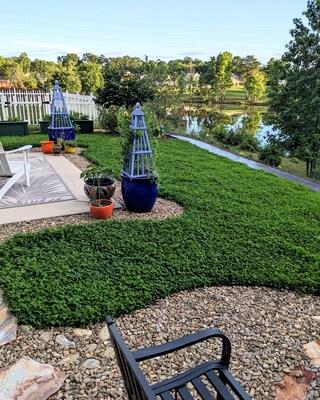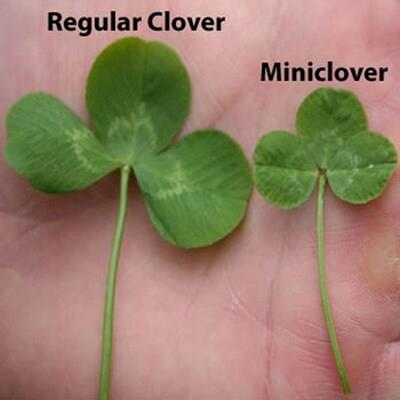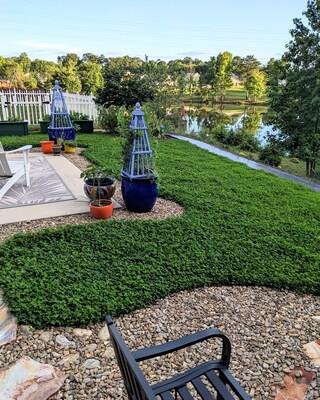
Outsidepride Encourages Homeowners To Overseed Lawns With Miniclover, A Sustainable, Smart, Eco-Friendly Alternative To Grass Seed

Clover is one of the best grass lawn alternatives available. It's a tough perennial and doesn't require the care of grass to look green and gorgeous. Miniclover stays greener longer, producing a thick, carpet-like look. It grows fast, thrives in partial shade or sun, and is drought tolerant.

Size comparison of Miniclover and Dutch White clover
If you're an eco-conscious homeowner, or just love gorgeous green surrounding your home, it may be difficult to justify the expense, water usage and chemicals involved in modern lawn maintenance. Smart, eco-friendly homeowners are finding a sure-fire alternative in a lush, green, fast-growing, groundcover that's popping up nearly everywhere. As interest grows in natural, diverse, ecological ground covers,
consider overseeding your lawn with an option like Miniclover,
(Trifolium repens). Unlike white Dutch clover, Miniclover has smaller leaves, fewer flowers, and a lower growth habit, blending discretely with an existing lawn. It blooms just once, in year two, and if desired flowers can be eliminated with mowing.
Miniclover has been making its mark on social media. That may seem surprising, since clover has long been counted among lawn weeds to combat. But in the wake of dwindling pollinators, climate change and an overall rethink of the composition of lawns and how they're maintained, alternatives like Miniclover are rising in popularity.
Clover is now one of the best grass lawn alternatives available.
It's a tough perennial and doesn't require the care of grass to look green and gorgeous.
Miniclover stays greener longer, producing a thick, carpet-like look. It grows fast, thrives in partial shade or sun, is drought tolerant – and it takes nitrogen from the air and "fixes" it in the soil, eliminating the need for nitrogen plant food, keeping lawns green while adding natural nitrogen to surrounding vegetation and soil. Miniclover grows approximately 4 - 6 inches tall, which is ideal for overseeding lawns. Adding even a small amount to an existing lawn will improve color, increase drought tolerance, and suppress weeds.
With increasingly strict water rationing, Miniclover's deep roots help it grow, after establishment, with once-a-week watering, or less. Miniclover is recommended for toughening up lawns, improving density, and it germinates quickly, filling bare spots fast. It requires no chemical fertilizers, herbicides, or pesticides, and it's less expensive than grass seed. Once established, Miniclover provides an uninterrupted field of green and doesn't turn yellow-even when four-legged friends take care of business.
"Using Miniclover to replace or overseed lawns is rising to levels I haven't seen before,"
said Troy Hake, President and owner of
Outsidepride ,
offering drought-tolerant grasses, clovers, wildflowers, and more. "It's obvious homeowners are seeking sustainable options to turf lawns, and evidenced by increased sales and numerous conversations on social and other media. Miniclover is a natural solution for self-sustaining, low-maintenance lawns that look beautiful and they're healthier for people, pets, soil, and waterways. You can't go wrong with it."
To get started, dethatch the lawn, as needed. Use a rake to scrape away leaves, clippings, and debris, exposing soil, ready for seed application. Next, grab a handful of Miniclover seeds and lightly sprinkle across the prepared lawn. Finally, sprinkle some topsoil over the seeds without covering them completely. Then, continuously water well, keeping soil moist until seedlings pop up within a couple of weeks.
Sustainable alternatives like Miniclover often have greater resilience to climate change impacts. It's time to rethink typical lawns and contribute to sustainability efforts, fostering a greener future. Sounds too good to be true? It's not. Give it a try.
Please visit Outsidepride .
Media Contact:
Joan Casanova
[email protected]
203-292-8820
SOURCE Outsidepride
WANT YOUR COMPANY'S NEWS FEATURED ON PRNEWSWIRE? 440k+Newsrooms &
Influencers 9k+
Digital Media
Outlets 270k+
Journalists
Opted In GET STARTED

Legal Disclaimer:
MENAFN provides the
information “as is” without warranty of any kind. We do not accept
any responsibility or liability for the accuracy, content, images,
videos, licenses, completeness, legality, or reliability of the information
contained in this article. If you have any complaints or copyright
issues related to this article, kindly contact the provider above.





















Comments
No comment